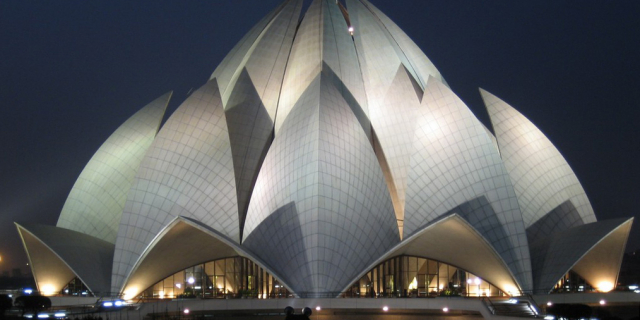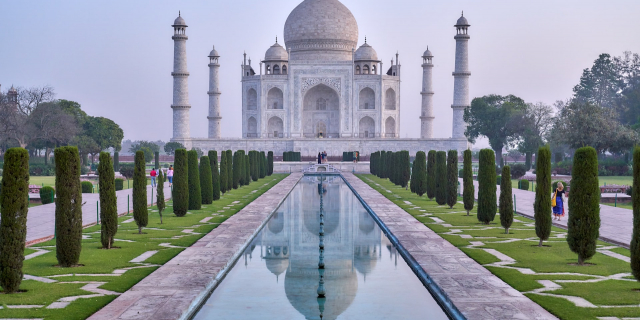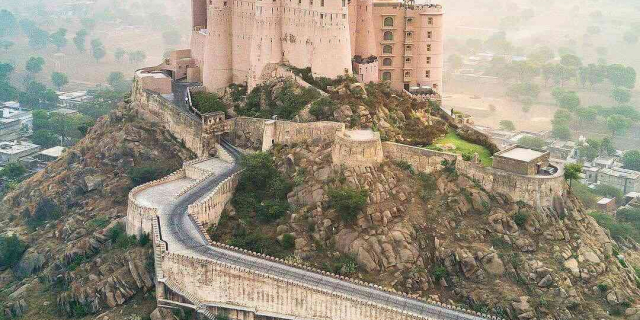क़ुतुब मीनार
( Qutb Minar )
The Qutb Minar, also spelled Qutub Minar and Qutab Minar, is a minaret and "victory tower" that forms part of the Qutb complex, which lies at the site of Delhi's oldest fortified city, Lal Kot, founded by the Tomar Rajputs. It consists of 399 steps It is a UNESCO World Heritage Site in the Mehrauli area of South Delhi, India. It is one of the most visited tourist spots in the city, mostly built between 1199 and 1220.
It can be compared to the 62-metre all-brick Minaret of Jam in Afghanistan, of c. 1190, which was constructed a decade or so before the probable start of the Delhi tower. The surfaces of both are elaborately decorated with inscriptions and geometric patterns. The Qutb Minar has a shaft that is fluted with "superb stalactite bracketing under the balconies" at the top of each stage. In general, minarets were slow to be used in India and are often detached from the main mosqu...Read more
The Qutb Minar, also spelled Qutub Minar and Qutab Minar, is a minaret and "victory tower" that forms part of the Qutb complex, which lies at the site of Delhi's oldest fortified city, Lal Kot, founded by the Tomar Rajputs. It consists of 399 steps It is a UNESCO World Heritage Site in the Mehrauli area of South Delhi, India. It is one of the most visited tourist spots in the city, mostly built between 1199 and 1220.
It can be compared to the 62-metre all-brick Minaret of Jam in Afghanistan, of c. 1190, which was constructed a decade or so before the probable start of the Delhi tower. The surfaces of both are elaborately decorated with inscriptions and geometric patterns. The Qutb Minar has a shaft that is fluted with "superb stalactite bracketing under the balconies" at the top of each stage. In general, minarets were slow to be used in India and are often detached from the main mosque where they exist.
In recent years, the Qutub Minar has been illuminated for special occasions involving international relations. In September 2023, the monument was lit up in the colors of the Mexican flag to celebrate Mexico's 213th Independence Day, an event that was acknowledged and appreciated by the Embassy of Mexico in India. Similarly, on October 30, the Qutub Minar was illuminated with the Turkish flag to commemorate the 100th anniversary of the Republic of Turkey, an occasion that received special attention from the Turkish Embassy in New Delhi.
The Qutb Minar was built over the ruins of the Lal Kot, the citadel of Dhillika.[1] Qutub Minar was begun after the Quwwat-ul-Islam Mosque. Drawing references from their Ghurid homeland, Qutub-ud-Din Aibak and Shamsu’d-Din Iltutmish constructed a minar (minaret) at the south-eastern corner of the Quwwatu’l-Islam between 1199 and 1503.[2]
 Kuttull Minor, Delhi. The Qutb Minar, 1805.
Kuttull Minor, Delhi. The Qutb Minar, 1805.It is usually thought that the tower is named for Qutb-ud-din Aibak, who began it. It is also possible that it is named after Khwaja Qutbuddin Bakhtiar Kaki a 13th-century sufi saint, because Shamsuddin Iltutmish was a devotee of his.[3]
The Minar is surrounded by several historically significant monuments of the Qutb complex. Quwwat-ul-Islam Mosque, to the north-east of the Minar was built by Qutub-ud-Din Aibak in A.D. 1199. It is the earliest extant - mosque built by the Delhi Sultans. It consists of a rectangular courtyard enclosed by cloisters, erected with the carved columns and architectural members of 27 Jain and Hindu temples, which were demolished by Qutub-ud-Din Aibak as recorded in his inscription on the main eastern entrance.[4] Later, a lofty arched screen was erected, and the mosque was enlarged, by Shams-ud- Din Itutmish (A.D. 1210–35) and Ala-ud-Din Khalji. The Iron Pillar in the courtyard bears an inscription in Sanskrit in Brahmi script of fourth century A.D., according to which the pillar was set up as a Vishnudhvaja (standard of god Vishnu) on the hill known as Vishnupada in memory of a mighty king named Chandra.[4]
The mosque complex is one of the earliest that survives in the Indian subcontinent.[5][1]
The nearby pillared cupola known as "Smith's Folly" is a remnant of the tower's 19th century restoration, which included an ill-advised attempt to add some more stories.[6][7]
In 1505, an earthquake damaged Qutub Minar; it was repaired by Sikander Lodi. On 1 September 1803, a major earthquake caused serious damage. Major Robert Smith of the British Indian Army renovated the tower in 1828 and installed a pillared cupola over the fifth story, creating a sixth. The cupola was taken down in 1848, under instructions from The Viscount Hardinge, who was the Governor General of India. at the time. It was reinstalled at ground level to the east of Qutb Minar, where it remains. This is known as "Smith's Folly".[8]
It was added to the list of World Heritage Site by UNESCO in 1993.
































Add new comment